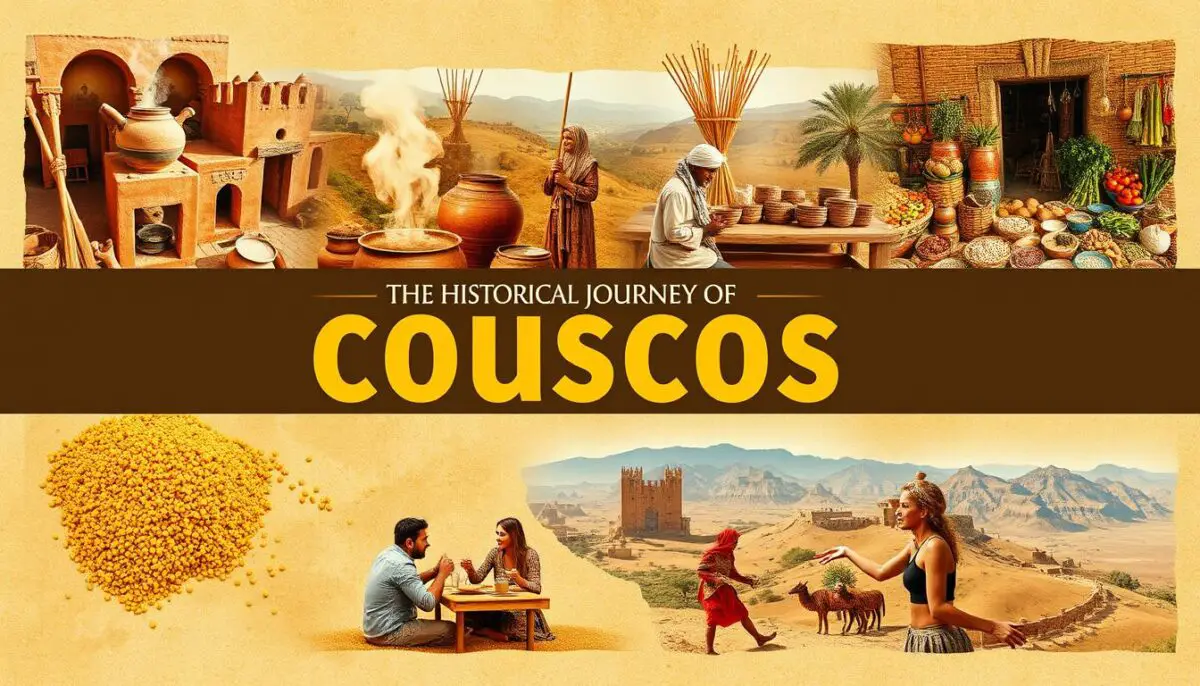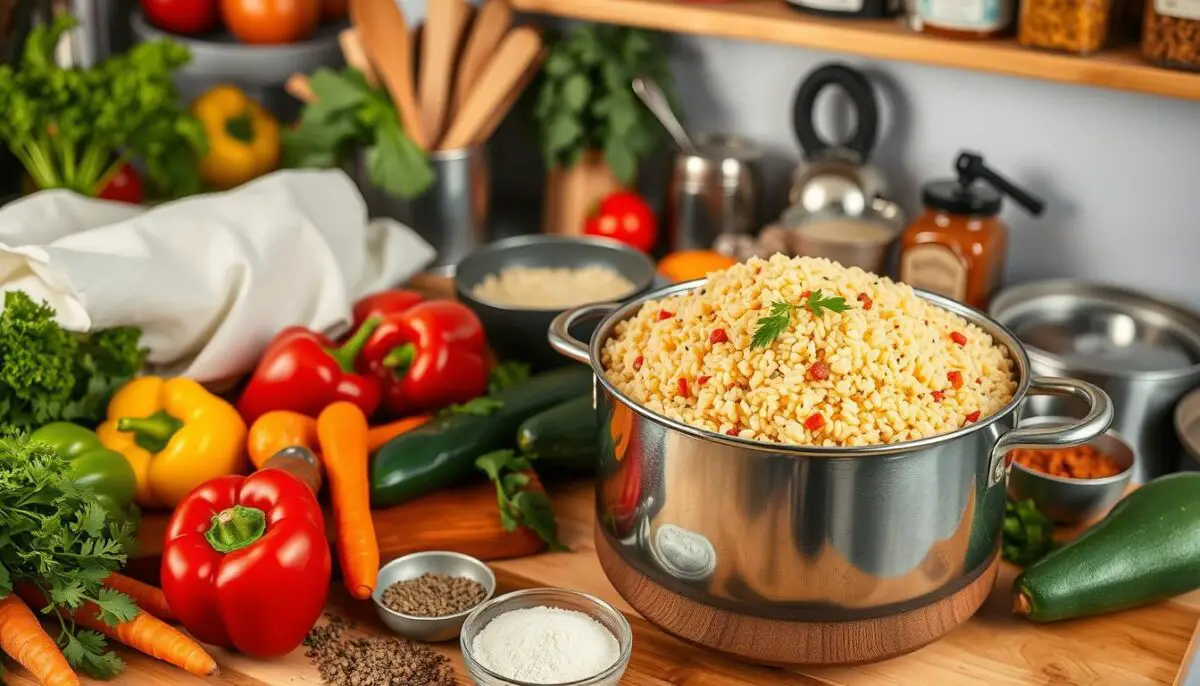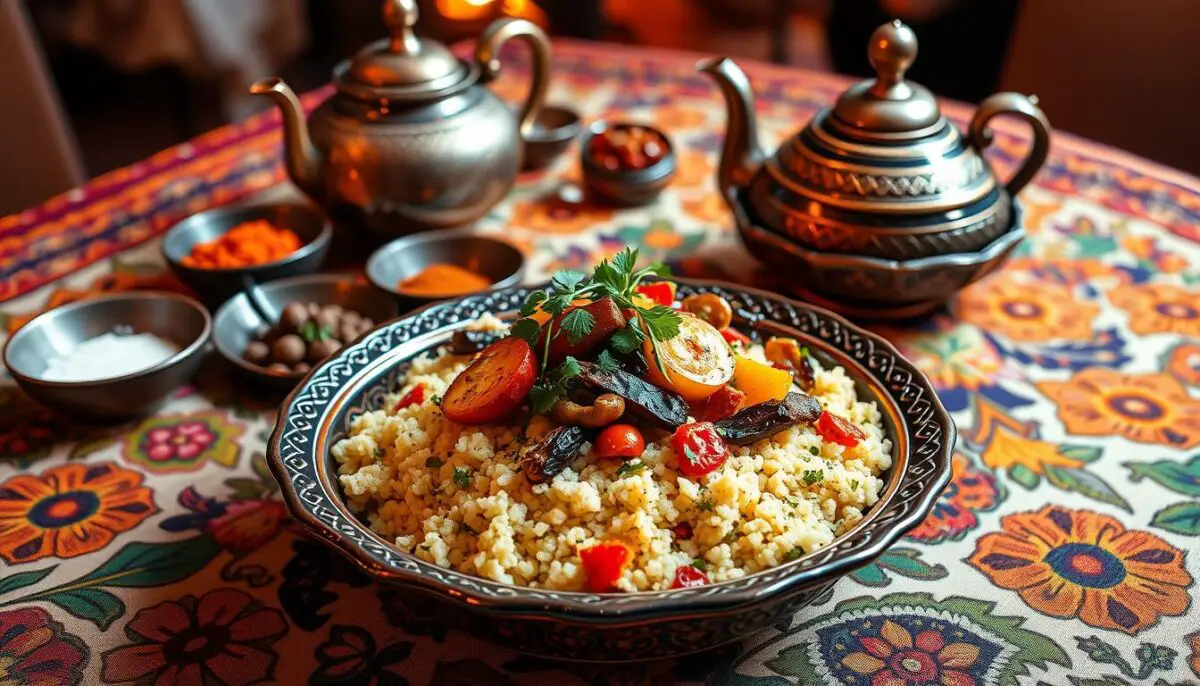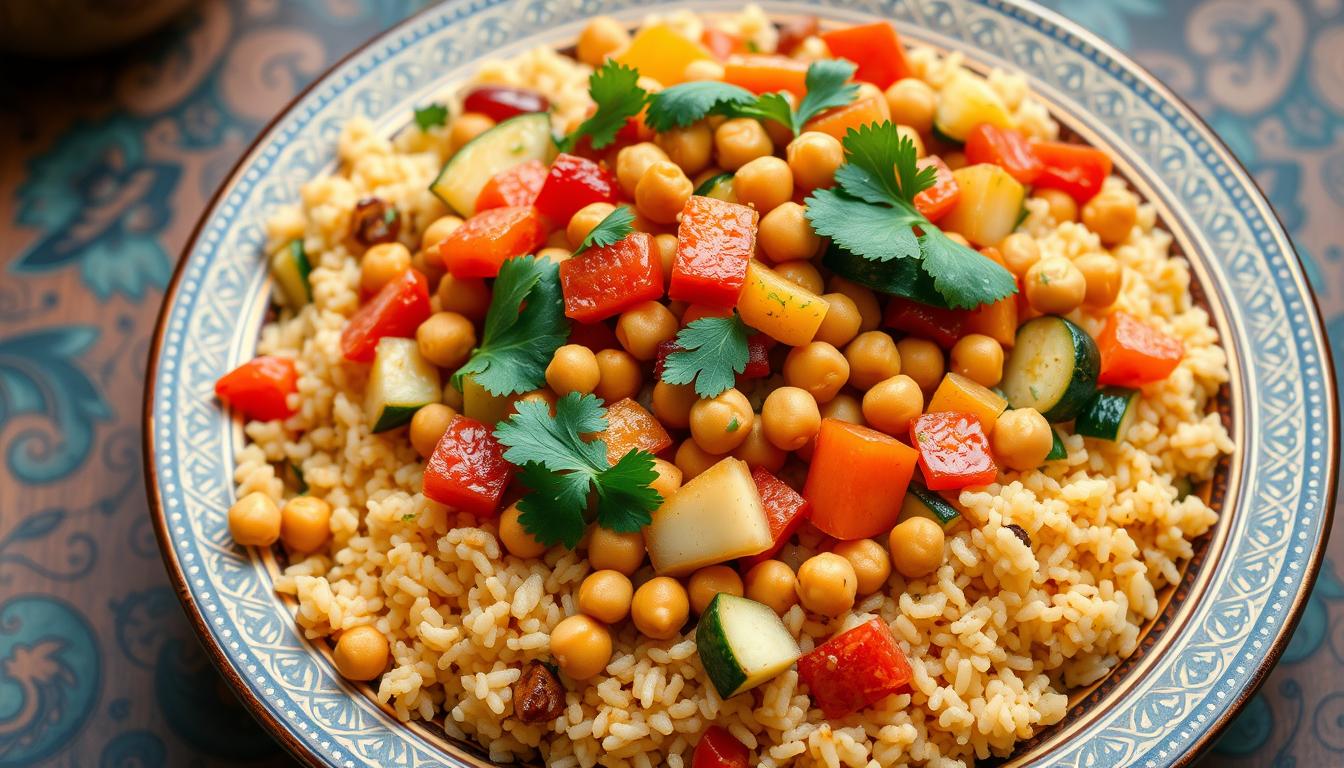Welcome to a vibrant Moroccan dish that’s a feast for the eyes and a healthy meal for any time. This Moroccan couscous recipe combines savory and aromatic vegetables, capturing the heart of vegetarian Moroccan cuisine. As you explore this dish, you’ll see how its unique flavors and cooking methods turn a simple meal into a joyful experience.
Get ready to enjoy a colorful mix of ingredients. Let the enticing tastes of Morocco inspire your next meal.
Key Takeaways
- This vibrant Moroccan dish offers a delightful balance of flavors and colors.
- It serves as a healthy couscous meal perfect for any diet.
- Discover the cultural significance of Moroccan cuisine.
- Learn about the unique ingredients that make this dish stand out.
- Experience versatile serving suggestions to enhance your meal.
Introduction to Moroccan Cuisine
Moroccan cooking is a mix of flavors and traditions. It combines Berber, Arab, and Mediterranean influences. The use of spices in Moroccan food is bold and diverse. Spices like cumin, coriander, saffron, and paprika give Moroccan dishes their unique aroma.
At the core of Moroccan cooking is the idea of sharing meals together. Families come together for couscous or tagine, enjoying a variety of dishes. Fresh vegetables, fruits, and herbs add to the flavor and make meals special.
Moroccan cuisine is more than just ingredients. Techniques like slow-cooking and steaming blend flavors together. This approach shows respect for tradition while welcoming new ideas, making Moroccan food a journey of taste and culture.
The Origins of Couscous
The history of couscous goes back to the Maghreb region. It became a staple food over a thousand years ago. These couscous origins show how it grew from simple grains to a dish loved globally.
Making couscous is a careful process passed down through generations. It involves steaming the grains many times to make them fluffy. This keeps couscous special, like in couscous in Moroccan culture, where it’s key at family meals and festivals.
Couscous brings people together, showing unity and friendship. Families gather to eat, share stories, and laugh. This highlights couscous’s deep cultural value. Over time, it has kept its traditions while also changing to fit new tastes, becoming a beloved comfort food.

| Aspect | Details |
|---|---|
| Region of Origin | Maghreb (North Africa) |
| Historical Significance | Staple food for centuries |
| Preparation Method | Steaming and fluffing |
| Cultural Role | Communal gatherings and festivities |
Ingredients for Moroccan Couscous with Vegetables
Making a tasty Moroccan veggie dish starts with picking the right ingredients. Using a mix of vegetables makes the dish look good and healthy. It also adds lots of flavor.
Essential Vegetables
The heart of Moroccan couscous is its colorful vegetables. Here are some key ones:
- Carrots: Sweet and adds flavor.
- Zucchini: Moist and a bit crunchy.
- Bell Peppers: Colorful and flavorful, making the dish look great.
- Chickpeas: Full of protein and makes the dish hearty.
These vegetables make the dish look good and taste amazing.
Spices that Make a Difference
Choosing the right spices is key for authentic Moroccan taste. The spice mix makes the dish’s flavor pop:
- Cumin: Warm and earthy.
- Paprika: Sweet and adds color.
- Turmeric: Gives a bright yellow color and a unique taste.
- Ras el Hanout: A blend of many flavors, essential for a true Moroccan dish.
Using fresh, quality spices makes a big difference in taste. It ensures your dish tastes like it’s from Morocco.
| Vegetables | Benefits |
|---|---|
| Carrots | Rich in beta-carotene, promotes eye health |
| Zucchini | Low calorie, high fiber content |
| Bell Peppers | High in vitamins C and A, boosts immunity |
| Chickpeas | Excellent source of protein, keeps you fuller longer |
Together, these vegetables and spices make a dish that truly captures Moroccan cuisine’s spirit.
How to Prepare Couscous: A Step-by-Step Guide
Preparing couscous is easy and rewarding. This guide will show you how to make fluffy and flavorful grains. It’s perfect for both beginners and seasoned cooks.
- Measure the couscous – Start by measuring out the desired amount of couscous. A standard serving is typically about 1 cup per person.
- Boil water – In a saucepan, bring an equal amount of water to a boil. For every cup of couscous, use one cup of water.
- Add salt and oil – Stir in a pinch of salt and a tablespoon of olive oil to the water for added flavor.
- Combine water and couscous – Once the water is boiling, remove it from heat and pour in the couscous. Stir briefly to combine.
- Cover and steam – Cover the saucepan with a lid and let the couscous steam for about 5 minutes. This allows the grains to absorb the water and swell.
- Fluff the couscous – After steaming, use a fork to fluff the couscous gently. This helps separate the grains and prevents clumping.
- Prepare vegetables and spices – While the couscous steams, prepare your sautéed vegetables and spices of choice. This could include bell peppers, zucchini, and cumin for rich flavors.
- Mix everything together – Lastly, combine the fluffed couscous with the vegetables and spices, stirring gently until evenly distributed.
By following these steps, you’ll make a dish that goes well with many meals. Learning how to cook couscous opens up a world of culinary possibilities.

| Ingredient | Amount |
|---|---|
| Couscous | 1 cup |
| Water | 1 cup |
| Olive oil | 1 tablespoon |
| Salt | Pinch |
By following this guide, you’ll have a delicious dish that showcases Moroccan cuisine’s unique flavors.
Cooking Tips for Perfect Moroccan Couscous
To get a perfect couscous texture, pay close attention to detail and use the right cooking techniques. Follow these tips to make sure your Moroccan couscous is always light and fluffy.
Setting the Right Texture
For fluffy couscous, hydration is key. Start with the right couscous and water ratio, usually 1:1. Let the grains soak in hot water or broth for about 10 minutes to swell.
After soaking, gently fluff the couscous with a fork. This not only separates the grains but also makes them fluffier. Steaming is another great method; it helps keep the couscous light and tender.
Flavor Infusion Techniques
To make couscous more appealing, infuse it with flavors. Use vegetable or chicken broth instead of plain water to boost the taste. Adding fresh herbs like parsley or cilantro during cooking adds freshness.
To deepen the flavor, marinate vegetables in spices like cumin and paprika before mixing them with the couscous. Layering flavors throughout cooking makes the dish rich and engaging.
| Cooking Technique | Description | Benefits |
|---|---|---|
| Hydration | Soak couscous in hot water or broth for 10 minutes. | Creates swollen, fluffy grains. |
| Fluffing | Use a fork to gently separate the grains. | Prevents clumping and enhances texture. |
| Steaming | Steam couscous to achieve a light texture. | Creates tender grains and retains moisture. |
| Flavoring with Broth | Replace water with broth in preparation. | Deepens overall flavor profile. |
| Herb Incorporation | Add fresh herbs during cooking. | Adds freshness and aromatic qualities. |
| Vegetable Marination | Marinate veggies in spices before cooking. | Enhances overall flavor infusion. |
Benefits of Eating Vegetables
Eating vegetables is good for your health. They are full of vitamins, minerals, fiber, and antioxidants. These help keep you well.
Knowing the nutrition facts about vegetables helps you make better choices. This is true for plant-based dishes like Moroccan Couscous.
Vegetables help with weight control because they are low in calories and high in fiber. They also support heart health and reduce the risk of chronic diseases. Plus, they help with digestion.
| Vegetable | Calories (per 100g) | Fiber (g) | Vitamins | Antioxidants |
|---|---|---|---|---|
| Broccoli | 34 | 2.6 | C, K | Yes |
| Spinach | 23 | 2.2 | A, C, K | Yes |
| Carrots | 41 | 2.8 | A, K | Yes |
| Tomatoes | 18 | 1.2 | C, K | Yes |
Adding different vegetables to your meals makes them taste better. It also makes your diet healthier. A colorful plate is not just pretty. It’s also packed with nutrients.
Pairing Moroccan Couscous with Other Dishes
Moroccan Couscous is great for many tasty meals. It pairs well with traditional tagines, which mix meat, veggies, and spices. These stews have flavors that match the couscous’s light taste.
Grilled meats like lamb or chicken add a smoky flavor. This makes the meal even better.
For a fresh twist, try it with a citrus and herb salad. Adding nuts and dried fruits makes the salad even more interesting.
Drinks are key in these pairings. Moroccan mint tea or yogurt drinks are perfect. They clean your palate and add to the meal’s joy.
| Dish | Flavor Profile | Best Pairings |
|---|---|---|
| Tagine | Spicy and savory | Moroccan Couscous |
| Grilled Lamb | Smoky and rich | Fresh Salad |
| Citrus Salad | Refreshing and tangy | Yogurt Drink |
| Mint Tea | Sweet and herbal | Any Moroccan Dish |
Serving Suggestions for Moroccan Couscous
Serving couscous can turn a simple dish into a vibrant centerpiece for any Moroccan meal. Creative presentation ideas make the dish more appealing. They also show off the rich culture of Moroccan cuisine. Using traditional serving methods makes your meal feel more authentic.

Place couscous in a large, decorative tagine or on a platter to show off its colors. This invites guests to serve themselves, creating a sense of community. Add fresh herbs, nuts, and dried fruits for extra texture and taste. These touches highlight the variety of Moroccan meal styles and make the dish visually stunning.
Also, pick plates or bowls that match the dish’s colors. Earthy tones against the couscous’s bright yellows and greens look amazing. Using traditional Moroccan pottery can make the meal even more special.
| Serving Style | Description |
|---|---|
| Traditional Tagine | Highlighting the dish in a classic tagine allows for aromatic presentations and easy serving. |
| Platter Share | A large platter encourages family-style dining, where everyone enjoys a portion of the meal. |
| Colorful Garnishes | Adding fresh herbs, nuts, and dried fruits enhances flavor and visual appeal. |
| Elegant Tableware | Using Moroccan pottery adds authenticity and complements the vibrant colors of couscous. |
Choosing the right serving style makes the dish stand out and creates a memorable meal. Embracing these unique presentation ideas will surely impress your guests.
Vegan and Vegetarian Adaptations
Moroccan couscous is perfect for vegans and vegetarians. It’s easy to make it fit your diet. Just use fresh veggies for great taste and color.
Switching out animal products makes couscous healthier. Here are some good swaps:
- Chickpeas are full of plant-based protein. They add texture and taste great with spices.
- Tofu marinated and cooked is a protein-packed choice. It soaks up flavors well.
- Nuts like almonds or pistachios bring crunch and depth. They make the dish more enjoyable.
Spices are key to a lively dish. Use cumin, coriander, and turmeric to taste. Add fresh herbs like parsley or cilantro for a fresh twist.
Turning Moroccan couscous vegan or vegetarian is easy. It’s a tasty, filling meal for everyone. Serve it as a main or side, and it’s a hit in any meal.
Common Mistakes to Avoid When Cooking Couscous
Cooking couscous can be a fun experience. But, many mistakes can ruin the dish. Knowing how to avoid errors helps you make perfect couscous every time.
- Overcooking: Letting couscous cook too long is a big mistake. It makes the couscous mushy and unattractive.
- Inadequate Hydration: Not using enough water can make couscous dry and crumbly. It’s key to use the right amount of liquid.
- Neglecting Seasoning: Not seasoning couscous enough can make it taste bland. Adding spices and herbs can greatly improve the taste.
By avoiding these common mistakes, you can make couscous that tastes great and impresses your guests.
Conclusion
Moroccan Couscous is a key dish in Moroccan cuisine, showing off its rich culture. It’s a mix of flavors, textures, and colors that excites both the eyes and taste buds. We’ve looked into its history, main ingredients, and cooking methods that make any meal special.
Thinking about Moroccan Couscous, it’s more than a recipe. It’s a way to connect with Morocco’s culinary traditions. By making this dish, you feel the warmth of Moroccan hospitality. It lets you explore a rich history and culture through food.
Whether you’re new to cooking or experienced, making Moroccan Couscous is a fun journey. With what we’ve shared about Moroccan cuisine, it’s time to start this flavorful adventure. Get ready to wow your family and friends with this amazing dish!
FAQ
What is a Moroccan couscous recipe?
Moroccan couscous is a dish made with steamed couscous. It’s served with a mix of vegetables, spices, and sometimes meat. This dish is known for its fresh ingredients and is a big part of Moroccan and North African food.
Why is couscous considered an important dish in Moroccan culture?
Couscous is very important in Morocco. It’s often eaten during big gatherings and celebrations. It shows hospitality and brings people together, showing the value of sharing meals with family and friends.
What vegetables are commonly used in Moroccan couscous?
Carrots, zucchini, bell peppers, and chickpeas are key in Moroccan couscous. They make the dish look good and taste great, adding to its health benefits.
How can I enhance the flavor of my couscous?
To make your couscous taste better, use broth instead of water. Add fresh herbs and spices like cumin and paprika. Also, marinating the vegetables can make them taste richer.
What are some common mistakes to avoid when cooking couscous?
Don’t overcook the couscous or not soak it enough. Also, don’t season it too little. Following the right cooking and seasoning methods is key to a great couscous.
Are there vegan adaptations of Moroccan couscous?
Yes, you can make Moroccan couscous vegan. Use plant-based proteins like legumes and vegetable broth for flavor. This makes the dish suitable for vegans.
What spices are critical for an authentic Moroccan couscous dish?
For real Moroccan couscous, use cumin, coriander, paprika, turmeric, and ras el hanout. These spices give the dish its unique taste and flavor.
How can I serve Moroccan couscous beautifully?
To serve couscous well, add garnishes like fresh herbs, almonds, or dried fruits. Serve it in a big bowl for everyone to share. This makes the meal more enjoyable.
What beverages pair well with Moroccan couscous?
Moroccan mint tea and yogurt drinks go great with couscous. They offer a cool contrast to the warm spices and flavors of the couscous.
What are the health benefits of eating Moroccan couscous with vegetables?
Eating couscous with vegetables is good for you. It’s full of fiber, vitamins, minerals, and antioxidants. This makes it a healthy and tasty choice for a meal.

